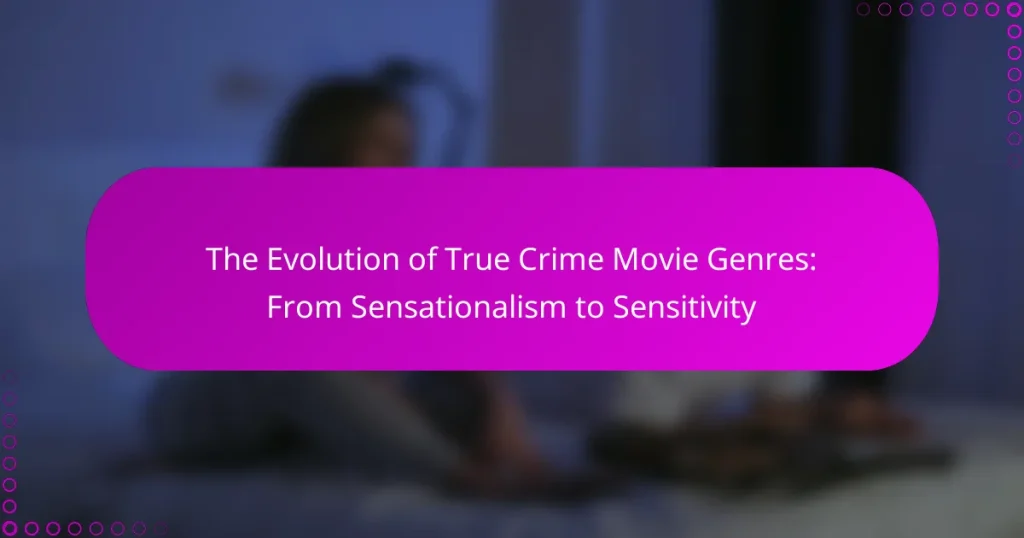The article examines the evolution of the true crime movie genre, highlighting the shift from sensationalism to sensitivity in storytelling. True crime movies dramatize real criminal cases, often involving serious crimes such as murder and fraud, while exploring the motives and consequences of criminal behavior. The piece discusses how sensationalism has historically heightened emotional engagement and viewer interest, contributing to the genre’s popularity. It also addresses the recent trend toward ethical storytelling, which prioritizes the perspectives of victims and their families, fostering empathy and awareness. This transformation reflects a growing audience preference for responsible content that emphasizes understanding over mere entertainment.

What is the True Crime Movie Genre?
The true crime movie genre focuses on dramatizations of real criminal cases. These films portray actual events, often involving murder, fraud, or other crimes. They aim to explore the motives and consequences of criminal behavior. True crime movies combine elements of documentary and narrative storytelling. This genre has gained popularity due to its engaging and often shocking content. Notable examples include “Zodiac” and “Monster.” The genre raises questions about morality and justice. It also reflects societal fascination with crime and the human psyche.
How has the True Crime Movie Genre evolved over time?
The True Crime Movie Genre has evolved significantly over time. Initially, it focused on sensationalism and graphic depictions of crime. Early films often exaggerated details to attract audiences. In the 1990s, a shift occurred towards more realistic storytelling. Documentaries began to blend factual reporting with dramatic reenactments. This led to a deeper exploration of criminal psychology and societal impacts. Recent films emphasize sensitivity towards victims and their families. They aim to provide a more nuanced portrayal of crime. Streaming platforms have also expanded accessibility to diverse true crime narratives. This evolution reflects changing audience expectations and cultural attitudes towards crime and justice.
What historical events influenced the development of True Crime Movies?
The development of True Crime Movies was influenced by several historical events. The rise of sensationalist journalism in the late 19th century played a significant role. High-profile criminal cases, such as the Jack the Ripper murders in 1888, captured public attention and fueled interest in crime stories. The introduction of film in the early 20th century allowed these narratives to be visualized. The 1930s saw the production of films like “The Public Enemy,” which depicted real-life criminals. The 1960s and 1970s brought a wave of documentaries that focused on true crime stories, such as “The Manson Family.” The advent of the internet in the late 20th century further popularized true crime content. Online platforms provided easy access to information about real crimes, influencing filmmakers. These historical milestones shaped the evolution of the genre towards a more sensitive portrayal of crime and its impacts on victims and society.
How did early True Crime Movies differ from contemporary ones?
Early True Crime Movies focused heavily on sensationalism and shock value. They often exaggerated details to attract audiences. These films prioritized entertainment over factual accuracy. In contrast, contemporary True Crime Movies emphasize realism and emotional depth. They aim to portray the psychological nuances of crime and its impact on victims. Modern films often include thorough research and interviews with those affected. This shift reflects a broader societal change towards sensitivity and understanding in storytelling.
What are the key characteristics of True Crime Movies?
True crime movies focus on real criminal cases and events. They often depict the investigation process in detail. These films aim to evoke emotional responses from the audience. They typically include interviews with real people involved in the cases. Authenticity is a key element, often using actual court documents and evidence. True crime movies frequently explore the psychological aspects of criminals. They may also highlight societal issues related to crime. The genre has evolved to incorporate more sensitivity towards victims and their families.
What themes are commonly explored in True Crime Movies?
True crime movies commonly explore themes of justice, morality, and the complexity of human nature. They often depict the pursuit of justice through law enforcement investigations. Morality is examined by showcasing the ethical dilemmas faced by characters. The complexity of human nature is illustrated through the motivations behind criminal behavior. These films frequently highlight the impact of crime on victims and their families. They also delve into societal reactions to crime and the media’s role in shaping public perception. Additionally, themes of redemption and rehabilitation are sometimes explored. The psychological aspects of both criminals and victims are often central to the narrative.
How do True Crime Movies portray real-life events?
True crime movies depict real-life events by dramatizing actual criminal cases. They often focus on notorious crimes, exploring the psychological aspects of both the perpetrator and the victims. These films typically include detailed narratives that highlight investigative processes. They aim to engage viewers through suspense and emotional storytelling. Real-life events are often modified for cinematic effect, which can lead to sensationalism. However, some films strive for accuracy, incorporating factual details and interviews with real-life figures involved. This approach can enhance authenticity and foster a deeper understanding of the events. The portrayal can influence public perception of crime and justice, as seen in various case studies.

What role does sensationalism play in True Crime Movies?
Sensationalism plays a significant role in True Crime Movies by heightening emotional engagement and viewer interest. It often emphasizes graphic details and dramatic narratives. This approach attracts audiences seeking thrilling and intense experiences. Sensationalism can lead to increased viewership and box office success. For example, films like “Zodiac” and “Monster” use sensational elements to captivate audiences. Research shows that sensationalized content can enhance memory retention of the events depicted. This is particularly effective in a genre that thrives on real-life horror and intrigue. Ultimately, sensationalism shapes the storytelling techniques used in True Crime Movies, influencing their reception and impact.
Why was sensationalism prevalent in early True Crime films?
Sensationalism was prevalent in early True Crime films due to the desire to attract audiences. Filmmakers used shocking narratives and graphic depictions to engage viewers. This approach played on the public’s fascination with crime and morality. The sensational content often overshadowed factual accuracy. Early films aimed to provoke emotional reactions, creating a spectacle. For example, films like “Murder in the First” highlighted gruesome details. This trend reflected societal anxieties about crime during that era. Consequently, sensationalism became a defining characteristic of early True Crime cinema.
What impact did sensationalism have on audience perception?
Sensationalism significantly altered audience perception by amplifying emotional responses and skewing reality. It often prioritized dramatic storytelling over factual accuracy. This approach led audiences to perceive crime narratives as more thrilling and engaging. Sensationalism frequently resulted in heightened fear and anxiety about crime rates. Studies have shown that sensationalized media can distort public understanding of crime prevalence. For instance, research by the Pew Research Center found that sensationalist news coverage can lead to misconceptions about crime safety. Consequently, audiences may develop biased views influenced by exaggerated portrayals. Overall, sensationalism shaped audience perceptions in ways that often diverged from actual crime statistics and realities.
How did sensationalism shape the narratives of True Crime Movies?
Sensationalism significantly shaped the narratives of True Crime Movies by emphasizing shocking details and dramatic storytelling. This approach often prioritizes entertainment over factual accuracy. Sensationalist elements include graphic depictions of violence and emotional manipulation. Such techniques attract viewers and create a heightened sense of intrigue. For example, films often focus on notorious criminals and sensational cases. This leads to a skewed perception of crime and its prevalence. Research shows that sensationalized portrayals can influence public fear and societal attitudes toward crime. Overall, sensationalism has driven the popularity and narrative style of True Crime Movies.
What are the criticisms of sensationalism in True Crime Movies?
Sensationalism in true crime movies is criticized for prioritizing entertainment over factual accuracy. This approach can distort real-life events and misrepresent victims and their families. Critics argue that sensationalism desensitizes audiences to violence and trauma. It may also perpetuate stereotypes about crime and criminal behavior. Studies show that sensationalized portrayals can lead to public misconceptions about crime rates and safety. Furthermore, such films often exploit tragedies for profit, raising ethical concerns. Sensationalism can overshadow the complexities of criminal cases, reducing them to mere spectacles. This trend may hinder meaningful discussions about justice and societal issues.
How do critics argue that sensationalism affects storytelling?
Critics argue that sensationalism negatively impacts storytelling by prioritizing shock value over depth. This approach often leads to superficial narratives that lack emotional resonance. Sensationalism can distort facts, creating misleading portrayals of events and individuals. Critics highlight that this practice undermines authentic representation and ethical storytelling. For instance, sensationalized true crime films may exploit victims’ tragedies for entertainment. This can result in desensitization among audiences. Research indicates that sensationalism can skew public perception of crime and justice. Overall, critics maintain that such storytelling diminishes the potential for meaningful engagement with real-life issues.
What ethical concerns arise from sensationalist portrayals?
Sensationalist portrayals raise significant ethical concerns. They can distort reality and misrepresent facts. Such portrayals often prioritize entertainment over accuracy. This can lead to misinformation among the audience. Victims and their families may experience further trauma due to sensationalism. It can also perpetuate stereotypes and stigmatize certain groups. Additionally, sensationalism may glorify violence and criminal behavior. Research shows that media representations can influence public perception and policy.

How has sensitivity changed the approach to True Crime Movies?
Sensitivity has shifted the approach to True Crime Movies by prioritizing ethical storytelling. Filmmakers now focus on the impact of crime on victims and their families. This change involves a more respectful portrayal of real-life events. The narrative often emphasizes empathy rather than sensationalism. Documentaries and films increasingly include the perspectives of those affected by crime. This approach aims to foster understanding and awareness rather than mere entertainment. Research indicates that audiences prefer these sensitive portrayals, leading to a rise in demand for responsible content. Overall, sensitivity has transformed True Crime Movies into more thoughtful and impactful narratives.
What factors contributed to the shift towards sensitivity in True Crime storytelling?
The shift towards sensitivity in True Crime storytelling is influenced by increased awareness of victims’ rights. This awareness has led creators to prioritize the dignity of those affected by crime. Additionally, the rise of social media has amplified public discourse on ethical storytelling. Audiences now demand narratives that respect the humanity of victims rather than sensationalizing their suffering. Furthermore, the impact of documentaries and podcasts has shifted expectations towards more responsible, fact-based narratives. Research indicates that viewers prefer content that fosters empathy and understanding over shock value. This evolution reflects broader cultural changes emphasizing compassion and social responsibility in media.
How have audience expectations influenced this change?
Audience expectations have significantly influenced the evolution of true crime movie genres. Initially, audiences favored sensationalism, leading filmmakers to prioritize shocking content. However, as viewers became more aware of the ethical implications, they began demanding sensitivity and authenticity. This shift is evident in the rise of documentaries that focus on victims’ stories rather than glorifying criminals. Research indicates that films like “The Keepers” and “Making a Murderer” reflect this change by emphasizing empathy and social justice. Consequently, filmmakers have adapted their narratives to align with these evolving expectations, prioritizing responsible storytelling over mere entertainment.
What role do filmmakers play in promoting sensitivity?
Filmmakers play a crucial role in promoting sensitivity by crafting narratives that highlight the complexities of real-life events. They can portray victims’ experiences with empathy, encouraging audiences to understand their struggles. Filmmakers often collaborate with experts and communities to ensure accurate representation. This approach fosters awareness and compassion towards sensitive subjects. For example, films like “The Pursuit of Happyness” illustrate the challenges faced by marginalized individuals. Such portrayals can spark conversations about social issues, leading to greater societal understanding. By prioritizing sensitivity, filmmakers contribute to a more informed and empathetic audience.
How do contemporary True Crime Movies handle sensitive subjects?
Contemporary true crime movies handle sensitive subjects with increased awareness and responsibility. They often prioritize the perspectives of victims and their families. Filmmakers aim to avoid sensationalism by focusing on factual storytelling. Many productions consult with experts to ensure accuracy and sensitivity. This approach helps to humanize the subjects rather than objectify them. For instance, films may include interviews with family members to provide context. Additionally, disclaimers about potential triggers are becoming common. This evolution reflects a broader cultural shift towards empathy and understanding in media representation.
What techniques are used to portray real-life tragedies with sensitivity?
Techniques to portray real-life tragedies with sensitivity include careful storytelling, character development, and emotional authenticity. Filmmakers often focus on the human experience rather than sensational details. This approach fosters empathy and understanding. They may also consult with victims’ families to ensure respectful representation. Cinematic techniques, such as subdued lighting and music, enhance emotional depth. Documentaries often use interviews to provide personal insights. These methods create a connection between the audience and the subject matter. Research shows that sensitive portrayals can lead to increased awareness and discussion about important social issues.
How do viewer reactions differ between sensationalist and sensitive portrayals?
Viewer reactions differ significantly between sensationalist and sensitive portrayals. Sensationalist portrayals often evoke shock and outrage. They tend to prioritize dramatic elements over factual accuracy. This can lead to heightened emotional responses, including fear or disgust. In contrast, sensitive portrayals foster empathy and understanding. They present narratives with depth and context, focusing on the human experience. Research indicates that viewers are more likely to engage thoughtfully with sensitive content. A study by the American Psychological Association found that sensitive portrayals can lead to increased compassion towards victims. This highlights the impact of narrative style on viewer perception and emotional response.
What can filmmakers learn from the evolution of True Crime Movies?
Filmmakers can learn the importance of balancing sensationalism with sensitivity in True Crime Movies. The evolution of this genre shows a shift from focusing solely on shock value to exploring deeper human experiences. Early True Crime films often prioritized graphic depictions of crime. This approach led to criticism for lacking empathy towards victims and their families. Over time, filmmakers began to incorporate more nuanced storytelling. They focused on character development and societal implications. This evolution has resulted in more engaging and responsible narratives. For instance, recent films like “Zodiac” and “The Jinx” emphasize psychological depth and moral complexity. Such films demonstrate that audiences appreciate authenticity and emotional resonance. Filmmakers can enhance their work by considering the broader impact of their stories.
What best practices should be followed in creating sensitive True Crime content?
Creating sensitive True Crime content requires a careful approach to storytelling. First, prioritize the dignity of victims and their families. Avoid sensationalizing tragedies and focus on factual reporting. Use respectful language and avoid graphic details that may cause distress. Conduct thorough research to ensure accuracy and context. Acknowledge the impact of crime on communities and individuals. Include diverse perspectives, particularly from those affected by the events. Always provide trigger warnings when discussing sensitive topics. These practices help maintain ethical standards in True Crime narratives.
How can filmmakers balance storytelling with ethical considerations?
Filmmakers can balance storytelling with ethical considerations by prioritizing authenticity and sensitivity. They should conduct thorough research to ensure accurate representation of real events and individuals. Engaging with affected communities fosters a deeper understanding of their perspectives. Filmmakers must also consider the potential impact of their narratives on audiences and subjects. Adhering to ethical guidelines, such as those proposed by the International Documentary Association, can guide responsible storytelling. By focusing on empathy and respect, filmmakers can create compelling narratives without compromising ethical standards.
The main entity of the article is the True Crime Movie Genre, which has evolved from sensationalist portrayals of criminal cases to more sensitive representations. The article examines the historical influences on the genre, key characteristics, and the impact of sensationalism on audience perception. It details the shift towards ethical storytelling, emphasizing the importance of empathy and respect for victims and their families. Additionally, it outlines best practices for filmmakers in creating responsible true crime content while balancing storytelling with ethical considerations.


